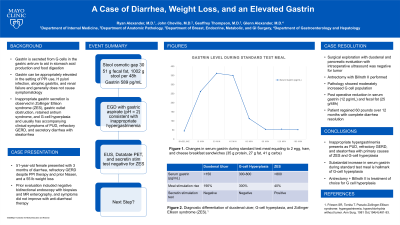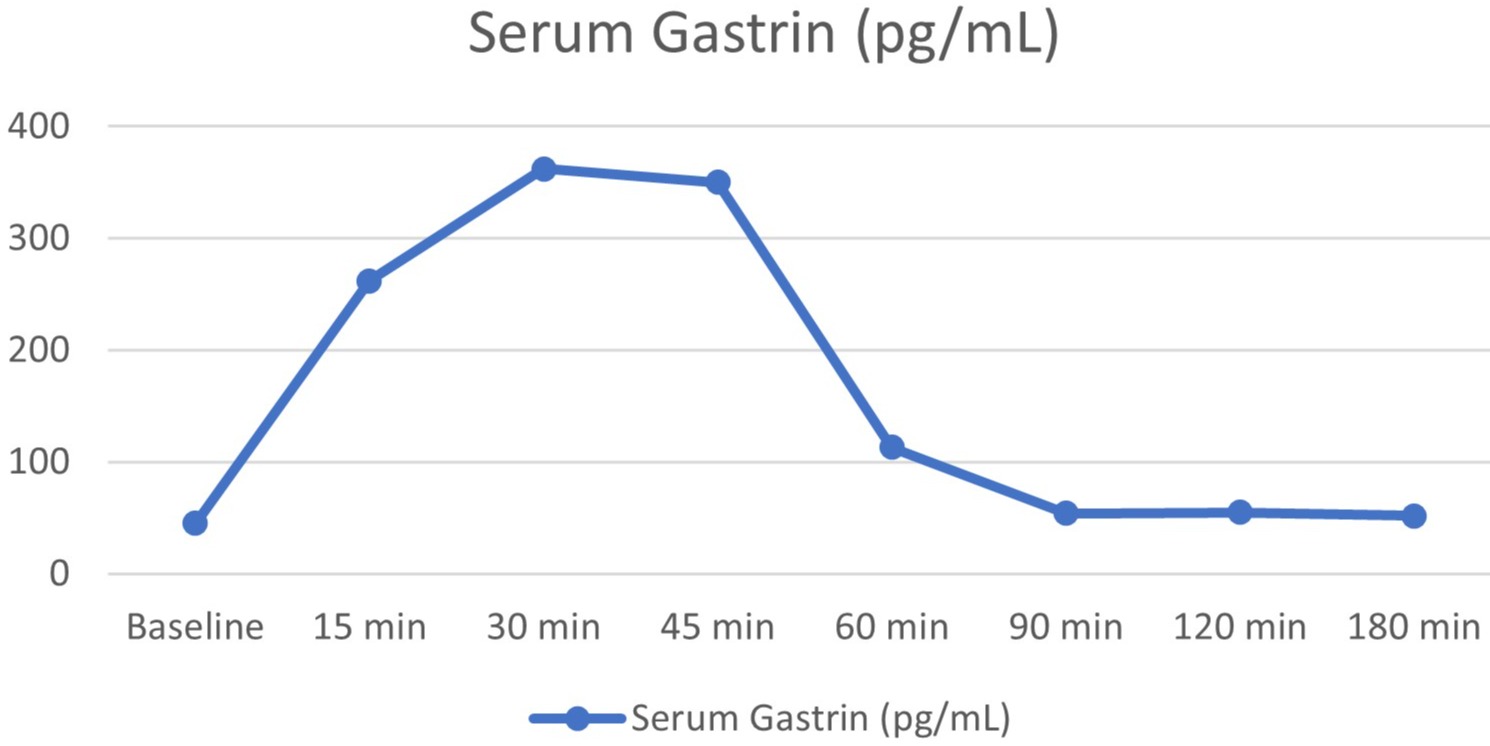Tuesday Poster Session
Category: Stomach
P4248 - A Case of Diarrhea, Weight Loss, and an Elevated Gastrin
Tuesday, October 24, 2023
10:30 AM - 4:00 PM PT
Location: Exhibit Hall

Has Audio
- RA
Ryan Alexander, MD
Mayo Clinic
Rochester, Minnesota
Presenting Author(s)
Ryan Alexander, MD, John Cheville, MD, Geoffrey Thompson, MD, Glenn Alexander, MD
Mayo Clinic, Rochester, MN
Introduction: Hypergastrinemia in a patient with refractory gastroesophageal reflux, steatorrhea, or peptic ulcer disease with gastric pH below 4 is concerning for Zollinger-Ellison syndrome (ZE) but antral G cell hyperplasia can also present in this manner and clinically can be distinguished from ZE based on negative radiographic studies, negative secretory stimulation test, and a typical gastrin response to a standardized test meal. Treatment of G cell hyperplasia is surgical antrectomy and can relieve the associated symptoms secondary to hypergastrinemia.
Case Description/Methods: A 51-year-old female with a previous history of a Nissen fundoplication for refractory reflux presented with a three-month history of heartburn, diarrhea, and 55 pound weight loss. Evaluation included negative upper and lower endoscopies with normal small bowel and colonic biopsies and negative MR enterography. A 48-hour fecal fat study revealed 501 g of stool and 51 g of fat per 24 hours. A serum gastrin level off PPI was elevated at 589 pg/mL with a gastric pH of 2 on gastric aspirate suggestive of ZE. Her diarrhea did not respond to pancreatic enzyme replacement. An EUS, Dotatate PET scan, and secretin stimulation test were negative. A standardized tests meal with serial gastrin monitoring demonstrated an 8-fold increase in serum gastrin suggestive of G cell hyperplasia (Figure 1). Open abdominal exploration and close examination of the pancreas and duodenum with intraoperative ultrasound showed no evidence of a gastrinoma and an antrectomy and Billroth II anastomosis was performed. Pathology did not reveal dramatic G cell hyperplasia but postoperatively her gastrin was 12 pg/mL and 16 months postoperatively she had regained 60 pounds and complained of mild constipation requiring Colace and Dulcolax to promote bowel movements every 2-3 days.
Discussion: Antral G cell hyperplasia should be considered in patients with symptoms suggestive of gastrinoma with negative secretin stimulation testing and imaging studies. Standardized test meal demonstrates substantial ( >300%) increase in serum gastrin levels and antrectomy is the treatment of choice for otherwise refractory symptoms.

Disclosures:
Ryan Alexander, MD, John Cheville, MD, Geoffrey Thompson, MD, Glenn Alexander, MD. P4248 - A Case of Diarrhea, Weight Loss, and an Elevated Gastrin, ACG 2023 Annual Scientific Meeting Abstracts. Vancouver, BC, Canada: American College of Gastroenterology.
Mayo Clinic, Rochester, MN
Introduction: Hypergastrinemia in a patient with refractory gastroesophageal reflux, steatorrhea, or peptic ulcer disease with gastric pH below 4 is concerning for Zollinger-Ellison syndrome (ZE) but antral G cell hyperplasia can also present in this manner and clinically can be distinguished from ZE based on negative radiographic studies, negative secretory stimulation test, and a typical gastrin response to a standardized test meal. Treatment of G cell hyperplasia is surgical antrectomy and can relieve the associated symptoms secondary to hypergastrinemia.
Case Description/Methods: A 51-year-old female with a previous history of a Nissen fundoplication for refractory reflux presented with a three-month history of heartburn, diarrhea, and 55 pound weight loss. Evaluation included negative upper and lower endoscopies with normal small bowel and colonic biopsies and negative MR enterography. A 48-hour fecal fat study revealed 501 g of stool and 51 g of fat per 24 hours. A serum gastrin level off PPI was elevated at 589 pg/mL with a gastric pH of 2 on gastric aspirate suggestive of ZE. Her diarrhea did not respond to pancreatic enzyme replacement. An EUS, Dotatate PET scan, and secretin stimulation test were negative. A standardized tests meal with serial gastrin monitoring demonstrated an 8-fold increase in serum gastrin suggestive of G cell hyperplasia (Figure 1). Open abdominal exploration and close examination of the pancreas and duodenum with intraoperative ultrasound showed no evidence of a gastrinoma and an antrectomy and Billroth II anastomosis was performed. Pathology did not reveal dramatic G cell hyperplasia but postoperatively her gastrin was 12 pg/mL and 16 months postoperatively she had regained 60 pounds and complained of mild constipation requiring Colace and Dulcolax to promote bowel movements every 2-3 days.
Discussion: Antral G cell hyperplasia should be considered in patients with symptoms suggestive of gastrinoma with negative secretin stimulation testing and imaging studies. Standardized test meal demonstrates substantial ( >300%) increase in serum gastrin levels and antrectomy is the treatment of choice for otherwise refractory symptoms.

Figure: Figure 1. Serum gastrin level at baseline and various time points during standard test meal. Test meal consisted of three medium eggs, two slices of bacon, two slices of toast, and 8 ounces of 2% milk for total content of 35 g of protein, 27 g of fat, and 41 g of carbohydrates.
Disclosures:
Ryan Alexander indicated no relevant financial relationships.
John Cheville indicated no relevant financial relationships.
Geoffrey Thompson indicated no relevant financial relationships.
Glenn Alexander indicated no relevant financial relationships.
Ryan Alexander, MD, John Cheville, MD, Geoffrey Thompson, MD, Glenn Alexander, MD. P4248 - A Case of Diarrhea, Weight Loss, and an Elevated Gastrin, ACG 2023 Annual Scientific Meeting Abstracts. Vancouver, BC, Canada: American College of Gastroenterology.
